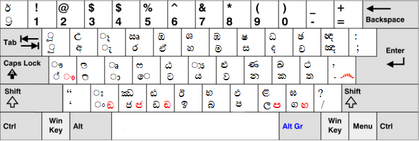Wijesekara keyboard
The Wijesekara keyboard is the standard typewriter keyboard for the Sinhala script. This keyboard layout was first created and approved by the government of Sri Lanka in 1964.

In 2004, it was given the SLS standards as the Sri Lanka Sinhala Character Code for Information Interchange, SLS 1134 : 2004. [2]
Implementations
The first standards compliant Sinhala Keyboard for Apple iOS was created by Bhagya Silva. This implementation featured a copyrighted custom layout that was based on SLS 1134:2004 optimised for mobile keyboards. [3]
Virtual Keyboards
The first Sinhala virtual keyboard is Helakuru. Helakuru was developed by Bhasha Lanka (Pvt) Ltd for Android and iOS devices. It was first released on Android in 2011 and in 2015 it was released on App Store also. [4] In 2019, Apple allowed Sinhala to be a keyboard layout and an iPhone language to boost Apple product sales in Sri Lanka.
